
Hans Christian Andersen’s Denmark Azerbaijan trip planner Eating local in the USA The Bahamas Patagonia Park Designing Copenhagen Alpine Slovenia South Africa � Europe’s most amazing RAIL JOURNEYS 30 Years Of Taking The Road Less Travelled






















































































































































































































































The Pyramids of Meroë, Sudan

The recent outbreak of internal fighting in Sudan brought uncomfortably to mind the ongoing invasion of Ukraine. The great loser when war breaks out is always the people, and it can often be in ways that aren’t immediately apparent. Few realise that Sudan is home to more standing pyramids – over 200 – than Egypt, thanks to the exploits of the Black Pharaohs who once ruled the Nile Valley. The Kingdom of Kush swept the region between 2500 BC and 300 AD, and in its ancient southern capital, Meroë (pictured), their legacy still scatters the dunes. This UNESCO-listed site is home to around 100 pyramids, recognisable by their steep slopes and narrow bases. Not all belonged to royals, but it is a spectacular sight nonetheless. While years of instability have held back visitors (and the much-needed income they bring to locals) from uncovering the stories that lie hidden in these ancient tombs, we hope to return in better times to witness the legacy of the Black Pharaohs once more.
© ImageBROKER/AWL
VIEWFINDER






Simien Mountains National Park, Ethiopia
Photographer: Marco Gaiotti

The ‘Big Five’ is a term safari-goers will be familiar with. It refers to the most prized wildlife sightings in Africa – elephant, lion, leopard, rhino, buffalo – however, few realise that it was coined in the 1800s by big-game hunters and based on how dangerous these animals were to hunt. It’s an odd phrase to have survived, so how about updating it for the photography age? That was the question posed by Graeme Green in The New Big 5. What started out as a way to celebrate the animal kingdom beyond the usual suspects soon turned into a global initiative aimed at raising awareness about the planet’s most fragile species, bringing together conservationists, photographers and travellers. After all, when seeing creatures such as the critically endangered Rüppell’s vulture (pictured) out in the wilds of Ethiopia, it’s hard not to think about what we all stand to lose. © Marco Gaiotti/New Big 5. The New Big 5: A Global Photography Project for Endangered Wildlife by Graeme Green; foreword by Paula Kahumbu, afterword by Jane Goodall (Earth Aware Editions; £62) is out now. insighteditions.com

VIEWFINDER

Palermo, Sicily, Italy


Photographer: Ana Menendez
The effect TV is having on the way we travel is growing. Since the Sicily-based second season of The White Lotus – a satire on the whims of mega-rich travellers – hit screens in late 2022, Italy’s boot tip has been in the spotlight. There will always be fans eager to live out their dreams – a themed tour by one local LGBTQ+ tour operator claimed to have sold out in record time – but within months of airing, Google Trends had already reported a doubling of searches for the region from the USA alone. There is certainly plenty to see beyond pretty Taormina, where the show is set, as Gianni Riotta’s new book, Sicily Honor, reminds us. From the historic centre of Palermo (pictured) and its dazzling Royal Palace to the Baroque streets of Noto and the Valley of the Temples, there are thousands of years of culture and history to see, not to mention the quiet menace of Mount Etna. It’s little wonder that TV cameras found their way there. It’s pure cinema. © Ana Menendez/Shutterstock. Sicily Honor by Gianni Riotta (Assouline; £70) is out now; eu.assouline.com
VIEWFINDER













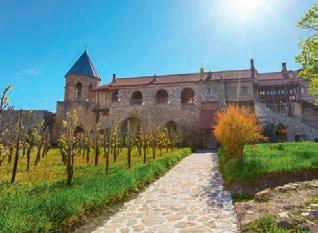





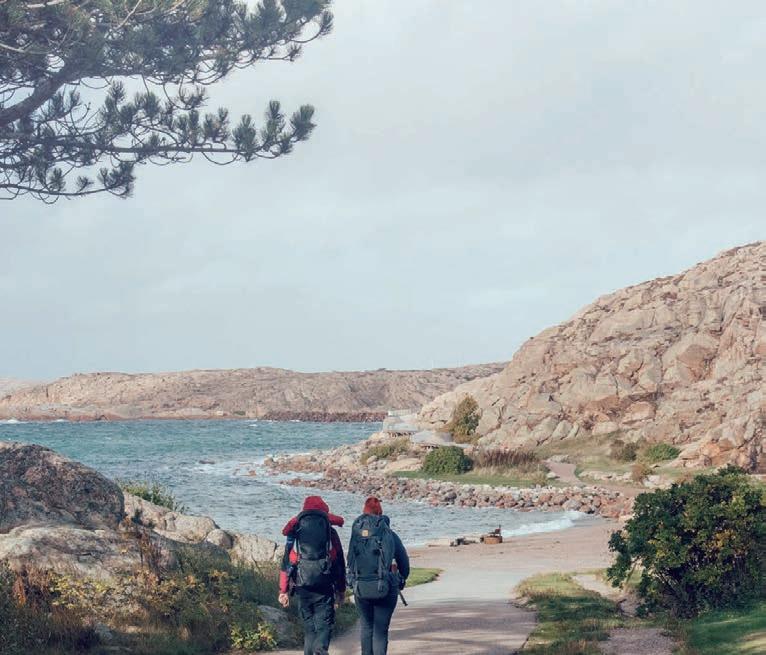














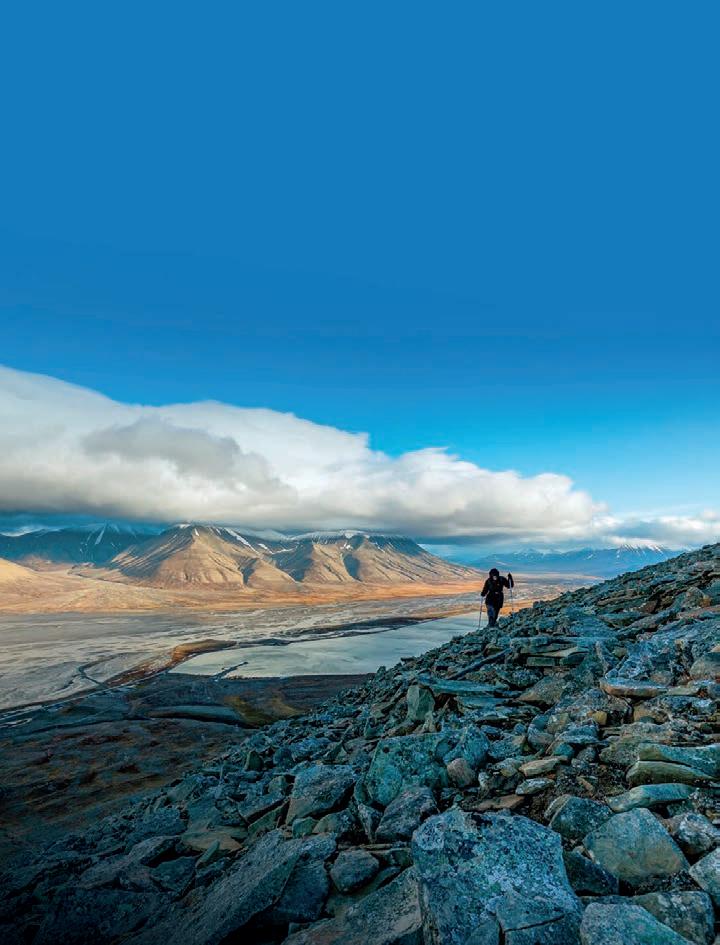











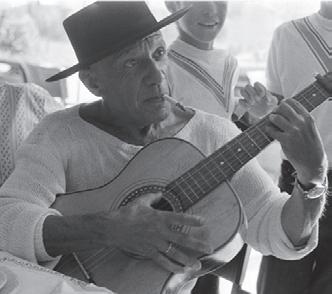


































Sleep easy
In the return of our regular health page, travelmedicine specialist Dr Nsisong Asanga offers advice on sleeping well while you’re away
Agreat night’s sleep calms, energises and prepares you to conquer the day. Over the long term, good sleeping habits are even proven to boost your immune system and help you live longer. However, for many people, this doesn’t come easy.
Nearly half of all British adults get less than seven hours’ sleep a night, according to the latest YouGov sleep tracker. When you add to that jet lag, unfamiliar environments, bright lights and a lack of legroom while travelling, sleep can be more elusive than a snow leopard sighting. As a consequence, not only will it be harder to get the most out of your trip, but it can make you prone to accidents and bad moods, and can increase hunger hormones.
“Travelling will most likely throw off your routine,” explained Dr David Rosen, a board-certified sleep medicine expert and co-founder of sleep-apnoea consulting service Renuma. “But you can take steps to reduce the impact.”
Here’s how to tip the scales in your favour and minimise disruption to your sleep patterns, no matter where you are, what time zone it is or how many miles you are from home.
START BEFORE YOU DEPART
You are more likely to sleep properly if you feel prepared. If you’re switching time zones, try adjusting your sleep time an hour earlier or later each day in the three days prior to travelling; this will help you sync with your destination. Set a clock or watch to the new time zone to get into the new rhythm.
If you have a choice of flight times, choose an arrival that will maintain your current sleep schedule and help you get to grips with the local time zone as soon as you arrive – try to sleep if it’s night or stay awake if it’s daytime.
PACK SLEEP ESSENTIALS
Research shows you sleep best when it’s dark, cool and comfortable, so plan ahead with some sleep aids. If
you’re easily disturbed by noise, pack ear plugs, earbuds or noise-cancelling headphones to block out interruptions.
An eye mask or even a portable blackout curtain can make the room as dark as possible, and bringing bedtime products like make-up remover or night cream will maintain a familiar routine and get you ready for sleep.
If weight or space restrictions aren’t a consideration for your luggage, you can even bring a weighted blanket or familiar pillow so you can settle in with your favourite accessories at hand.
ON THE MOVE
If it’s a long flight or your trip involves lots of moving around, a nap can be tempting; but don’t sleep too long or you may find it hard to drop off later.
“A power nap for 20 minutes can help you feel rested without throwing off sleep patterns,” added Dr Rosen.

Download soothing sounds or music so you can listen with your device in flight mode while in the air, and try deep breathing or a relaxation routine – researchers say counting sheep doesn’t work, but imagining a calm landscape might.
ROOM FOR IMPROVEMENT
The brain’s natural instinct is to remain alert when adjusting to a new environment, which is why it can be hard to sleep on your first night, but there are things you can do to maintain good ‘sleep hygiene’ and make your surroundings as calm as possible.
Have light meals and take it easy on alcohol, caffeine, nicotine or other stimulants that disrupt sleep. If you’re in a hotel, choose a room on a higher floor, at the end of a hallway, as those on lower floors or close to the stairs can be noisier. Get your room to an optimum temperature of 16–20ºC and block out as much light as possible.
The same rules apply when you return home – give yourself time before rushing back to work or other commitments so you can adjust your sleep patterns gradually.
FIND OUT MORE
The NHS offers resources to help assess sleep patterns and develop good habits. nhs.uk/every-mind-matters/mentalhealth-issues/sleep
The Sleep Charity has advice on sleep hygiene and good sleep environments. thesleepcharity.org.uk
The US-based Centers for Disease Control and Prevention (CDC) offers suggestions for catching enough Zzzs. cdc.gov/sleep
The National Sleep Foundation promises to help you find your ‘best-slept self’. thensf.org
Illustrations: Anil Karwal; images: Shutterstock
38 June/July 2023 HEALTH
7 WAYS TO SLEEP BETTER
1 Settle into a good sleep routine from the day you arrive – avoid naps and set a regular bedtime and wake-up time.

2 Get some sunlight early in the day to help reset your inner body clock.
3Take it easy in the evening – wind down from exercise or strenuous activity and resist the temptation to binge-watch your favourite shows.
4 Give yourself enough time to sleep – experts recommend seven to nine hours. If you have an early-morning safari drive or a busy day planned, be sure to set yourself a sensible bedtime.
5 Avoid using your phone, tablet or laptop in the hour before bed – these emit blue light, which can suppress melatonin levels.
6 Embrace calming practices such as reading, meditation, having a bath or listening to music or a podcast.
7 Have all your sleep accessories with you: headphones or ear plugs, socks, eye mask and familiar scents such as a lavender pillow spray.
SLEEP STATISTICS THE AVERAGE TIME TO FALL ASLEEP
10–20 MINS
ADD YEARS TO THE AVERAGE LIFE EXPECTANCY OF MEN AND WOMEN
Any more than two drinks can reduce sleep quality by almost 40%
A FULL MOON (though scientists aren’t sure why)
CAN MAKE SLEEP SHORTER AND MORE INTERRUPTED

www.wanderlustmagazine.com 39 JOURNAL Sleep
OF YOUR LIFE IS SPENT ASLEEP
1/3
CAN 4.7
GOOD SLEEP HABITS
2.4 YEARS
YEARS
LIMIT ALCOHOL CONSUMPTION























































































































To offset or not to offset?
Karen Edwards delves into the complex world of carbon offsetting, where it can be hard to know exactly what you’re paying for
Reducing emissions is currently at the centre of the conversation surrounding sustainable travel –and rightly so. According to a 2018 report by the International Council on Clean Transportation, commercial aviation contributes to around 2.4% of global carbon dioxide emissions, while a study published in the journal Atmospheric Environment found it responsible for 3.5% of all drivers of global warming. This might sound small in comparison to the contributions of other industries; however, with only an estimated 11% of the world’s population flying, and far less flying regularly, the individual carbon footprint of a traveller is especially heavy.
According to the latest Intergovernmental Panel on Climate Change report, if we continue on our current trajectory, we are likely to surpass the forewarned 1.5°C temperature rise above preindustrial levels as early as the 2030s. This would have a severe environmental effect. So, should we be counteracting our travel emissions via offsetting?
Carbon offsetting aims to balance the production of emissions via a donation, usually to a global initiative endeavouring to capture and store carbon dioxide using forests, plants and peatland, or via renewable energy projects. The process involves calculating your emissions per journey, establishing an equivalent cost, then finding a reputable scheme that will donate the corresponding credit to an offset project.
Critically, what is emitted through air travel can’t be immediately removed from the atmosphere. For this reason, it is misleading to consider travel, once offset, to be ‘carbon neutral’. Effective offsetting schemes can absorb a similar volume of carbon dioxide at some time in the future.
Well-managed offsetting initiatives can play a vital part of a longer-term solution for carbon capture, integrating education and community empowerment. Therefore, it can be worth offsetting unavoidable emissions through an independent and reputable provider, such as the World Land Trust (WLT), which partners with and empowers local and Indigenous communities to protect existing forest
POSITIVE NEWS
Setting the standard
A new set of standards, published in May by the Integrity Council for the Voluntary Carbon Market (ICVCM), now asks carbon-credit certifiers to demonstrate how credits are used to genuinely reduce emissions. The move aims to help consumers identify legitimate offset schemes.
environments. Closer to home,The Great Reserve cares for and responsibly plants giant sequoia forests around the UK. Unfortunately, the process comes with issues.The biggest of these is that travellers may become complacent and not attempt to actively reduce emissions. This lack of incentive could even encourage a growth in flight-related pollution: a recent report by The Travel Foundation predicts that emissions from long-haul trips could quadruple by 2050 without active change. Other issues include the mismanagement of offset schemes, which can lead to the displacement of Indigenous communities or the use of environmentally problematic non-native or monoculture plantations.
It’s also common to see initiatives offered by airlines when buying flights. While convenient, such schemes may not partner with reputable providers. Recently, it emerged in an investigation by the Guardian, Die Zeit and SourceMaterial that 90% of rainforest offset credits donated through the certifier Verra did not represent genuine carbon reductions. Choosing a provider with a proven track record is crucial (see sidebar).
The most efficient way to reduce an individual’s carbon footprint is to produce fewer emissions. However, this needn’t mean seeing less of the world. Instead, we can opt to take fewer long-haul trips but go for an extended period. Those who fly should keep in mind that take-offs and landings produce the most emissions, so direct flights are always preferable. Or perhaps we can reset our vision of what makes a great trip to incorporate slow travel, by train or ferry, wherever possible. The choice is in our hands.
HOW TO CALCULATE YOUR EMISSIONS
Use an independent online calculator such as the International Civil Aviation Organization (ICAO), which considers aircraft type, route-specific data, passenger load and cargo. applications.icao.int/icec
Overland to Berlin
Europe’s newest European Sleeper service means travellers can now go from London to Berlin in 16 hours by rail. Eurostar passengers can connect to the overnight service in Brussels, Belgium, and will reach Berlin early the following morning (see p132). europeansleeper.eu/en
Keeping the oceans clean Diving association PADI is encouraging travellers to seek out dive ‘Eco Centres’, an accreditation it is awarding to outfits that can provide proof of ongoing, measurable conservation activity, from running citizen science initiatives and beach clean-ups to coral restoration.
“Choosing a provider of carbon offsets with a proven track record is crucial”
56 June/July 2023 SUSTAINABLE TRAVEL
REPUTABLE OFFSETTING SCHEMES
Some airlines offer offset credits when buying flights. Such schemes are run in partnership with various offset initiatives and may not be transparent or effective. Instead, Wanderlust recommends offsetting with reputable, independent providers, such as the following…


World Land Trust
Partnering with local and Indigenous communities, WLT’s ‘Carbon Balanced’ programme aids in the protection of existing forests around the world. worldlandtrust.org
Atmosfair
Non-profit Atmosfair opts to support climate protection projects that focus on renewable energies and environmental education. co2offset.atmosfair.de/ co2offset
The Great Reserve
Bolstering the UK’s forests, The Great Reserve responsibly plants and preserves giant sequoia trees – the world’s fastestgrowing conifer – on home soil. thegreatreserve.org
Trees for Life
Established in 1981, this rewilding project replicates and grows native forests and wild bushland in South Australia through community engagement and education. treesforlife.org.au
Make It Wild
A family-run organisation that offers subscriptions to its tree-planting scheme. It contributes to rewilding projects in protected nature reserves in North Yorkshire. makeitwild.co.uk
Alamy www.wanderlustmagazine.com 57 JOURNAL Carbon Offsetting





















Settings to savour in Jordan

From Dead Sea resorts and desert retreats to camping in reserves where Bedouin traditions still hold fast, Jordan’s wild landscapes and ancient sites offer up stays that catch the eye… and imagination
Reviewed by Sunny Fitzgerald
64 June/July 2023 WANDERSLEEPS
Is there wifi on Mars? Want to sleep on another planet? The red sands of Wadi Rum are so otherworldly that they have become a go-to for Hollywood, having featured in sci-fi films ranging from The Martian to Prometheus

WADI RUM QUIET VILLAGE CAMP

Wadi Rum’s popularity means that it’s increasingly difficult to find the desert silence that many are seeking. Thankfully, this camp is tucked behind a towering mountain, so it’s sheltered from wind and noise yet still central enough to be within easy reach of the main trekking paths and climbing sites. Like many stays here, it offers basic Bedouin tents with shared facilities, but some of these also have heaters and en-suite bathrooms. However, if you’re keen to sleep out under the stars, that’s also possible during summer. There are certainly plenty of ways to make the most of your setting, with 4WD tours, camel rides (try a nighttime trek across desert dunes) and stories around the campfire. Tents from around £30 per night, including breakfast and dinner; wadirumquietvillage.camp
PEACE RESORT, AL HIMMAH
This newly opened hot-springs property on Jordan’s northern border is ideal for intrepid travellers seeking an escape from the well-trodden tourist trail. Situated in a rural community on the Yarmouk River in Al Himmah, the only crowds you’re likely to encounter are the occasional herd of goats or a flock of sheep crossing the narrow lanes as you approach. Minimal decor allows the natural beauty of the area to shine, and the indoor and outdoor kitchens on-site make it easy for guests to cook and barbecue whenever they wish, or opt for hearty, homecooked Jordanian fare prepared fresh by a local chef. And as well as birdwatching from the riverside hot springs, the resort can also arrange artisan workshops, tours and hikes with local experts. Rooms from around £140 per night, including breakfast; rent the entire property for £570 per night; discoverjordan.com

⊲
Alamy; Discover Jordan; Wadi Rum Quiet Village Camp
JOURNAL Jordan www.wanderlustmagazine.com 65
























DISPATCHES
Beyond the beaches
The Bahamas has changed a lot in its 50 years of independence, but there are still places where life is much the same and history and traditions run deep
Words & photographs by Lyn Hughes unless otherwise stated

JOURNAL The Bahamas


























DISPATCHES
The return of the wild
Locals in Argentina’s deep south are switching from ranching to eco-tourism as part of an effort to rewild Patagonia Park, the region’s newest reserve

Words & photographs
Richard Collett
JOURNAL Patagonia




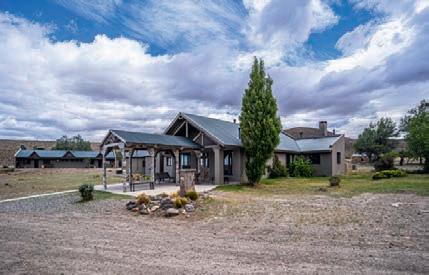











92 June/July 2023
FROM BRISBANE TO CAIRNS
Get acquainted with Queensland
Snorkelling the Great Barrier

Reef and unravelling First Nations culture are just some of the unique experiences that you will encounter in the Sunshine State. With help from Trailfinders, we tap into its staggering diversity…
Queensland is a region of extraordinary variety. The east coast of Australia’s Sunshine State stretches from the gleaming towers of Brisbane to the rainforest wilderness of the Cape York Peninsula, incorporating more than 2,500km of glorious, reef-fringed coastline along the way. As a destination, it’s nothing short of spectacular.
For travellers, however, it can be hard to know where to begin, which is where Trailfinders comes in. It has expert suggestions to help you get the most from this storied state, such as pairing the thrills of the Brisbane region with the beauty of the Tropical North. Here’s what to expect from a Queensland adventure...
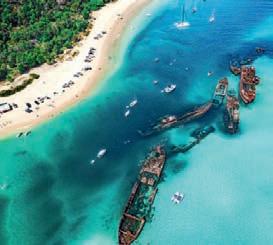
PROMOTIONAL FEATURE www.wanderlustmagazine.com 93 For more information, go to: Trailfinders.com or call 020 7084 6500
⊲ Tourism Tropical North Queensland


















THE LAND OF
A 400km road trip from Azerbaijan’s oil-rich capital to the Silk Road city of Sheki explores a country where the past is always smouldering just below the surface

Words & photographs by Simon Unwin unless otherwise stated


































PROMOTIONAL FEATURE
adventures await in GREECE GREEN
Your full guide to more sustainable travel in the cradle of civilisation

Iwas lucky enough to first visit Greece as a child in the 1970s, and like many before me fell in love with its unique beauty and its monuments from a time when Greece was the cradle of Western civilisation. But most of all, I loved its friendly, curious and resourceful people. Back then, rural habits were sustainable through necessity; nothing went to waste.
Since that time, the country has undergone a sea change. A far more prosperous Greece is now in the process of reinventing itself, creating a platform for a more sustainable future by combining the old ways with the latest technology.
This guide is among the first to delve into the transformative power of sustainable travel in Greece, showing how visitors can explore while helping to preserve the environment and support local communities. You won’t find the popular tourism hot spots in this guide, but instead authentic, lesser known and truly wonderful corners of this magnificent country.
www.wanderlustmagazine.com 117
Words Dana Faracos
























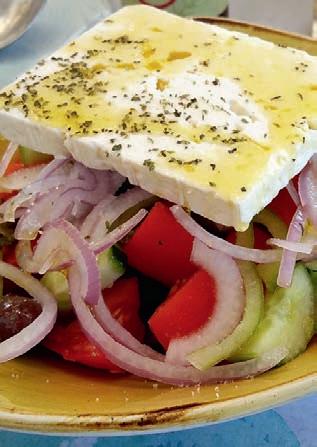





A Swiss first Switzerland’s GoldenPass Express is able to switch gauges, so travellers can ride between Montreux and Interlaken for the first time without having to change trains

EUROPE’S MOST EXCITING NEW
RAIL JOURNEYS
Travel in Europe is being transformed by a new wave of sleeper trains, high-speed connections and rail-themed tours. What better time to hit the tracks?
Words Anthony Lambert Map illustrations Scott Jessop










EUROPEAN RAIL JOURNEYS
THE BEAUTIFUL BASQUE COUNTRY TOUR

Eurostar and TGV trains carry you from London to Hendaye to begin this new eight-day tour of the Basque country.While based in the coastal walled town of Hondarribia, excursions include visits to the gastronomic centre of San Sebastián, beautifully sited around a crescent bay. When wandering the narrow streets of the Old Town, it’s worth calling at the San Telmo, the oldest museum in the Basque country, which has been converted from a 16th-century Dominican convent and offers insights into local culture. During your day in Bilbao, don’t miss Europe’s largest covered market: bustling fishmongers occupy its ground floor, while fruit, veg and meat lies upstairs. Though Frank Gehry’s Guggenheim Museum (pictured) is the architectural icon of the city, Norman Foster designed the metro stations with entrances as distinctive as the Paris Metro. Quieter moments can be found in the fishing village of Saint-Jean-de-Luz, whereas the topography is better understood by a journey on the rack railway up La Rhune for views over the Atlantic and the western tip of the Pyrénées. From £1,199pp; Rail Discoveries (01904 734939; raildiscoveries.com)

⊲ www.wanderlustmagazine.com 139
Alamy









EXPLORE SPAIN WITH IRYO


With Trenitalia as its largest shareholder, Iryo is the new rail operator in competition with Spanish state railway RENFE. Its first service, linking Madrid, Zaragoza and Barcelona, began last November, followed by Madrid–València a month later and trains to Córdoba, Seville and Málaga in March. A service to Alicante is expected to start in June.There are four classes of comfort, though all seats on its 360km/h Frecciarossa trains come with USB and standard sockets. But it’s the destinations that really shine. The attractions of Barcelona and Seville are well known, yet Córdoba is a revelation to many. Its narrow cobbled streets are a joy to wander, with glimpses into arcaded courtyards accompanied by the sound of water from a gentle fountain. However, it is the city’s palimpsest of a cathedral (pictured) that is most spellbinding: what was an 8th-century mosque, possibly built over a Visigothic church, was converted into a cathedral from 1236. Just walking through it conjures a sense of wandering among a forest of stone. Take time to also appreciate the Moors’ genius for engineering from remnants of their sluices and locks beside the River Guadalquivir, spanned by a traffic-free Roman bridge that is a popular haunt of buskers.
Elsewhere, Cuenca’s hanging houses, above the gorge of the River Huécar, are its most striking feature, but there are plenty of other delights to be found in a city that dates back to the 8th century. Equally well explored on foot is València, where extensive restoration of the old city and the towers of its defensive walls has greatly enhanced visits. As the birthplace of architect Santiago Calatrava, check out his bridge and the many spectacular buildings of the City of Arts and Sciences that were designed by him. One-way tickets: Madrid–Barcelona from £27.50; Madrid–València from £10; Madrid–Seville from £14; Madrid–Málaga from £16. iryo.eu
Alamy 144 June/July 2023
⊲ EUROPEAN RAIL JOURNEYS









HANS CHRISTIAN ANDERSEN
A new trail is turning a fresh page in the life of Denmark’s great storyteller, guiding travellers around the places that tell his own rags-to-riches fairy tale
Words & photographs Sarah Baxter

IN THE FOOTSTEPS OF
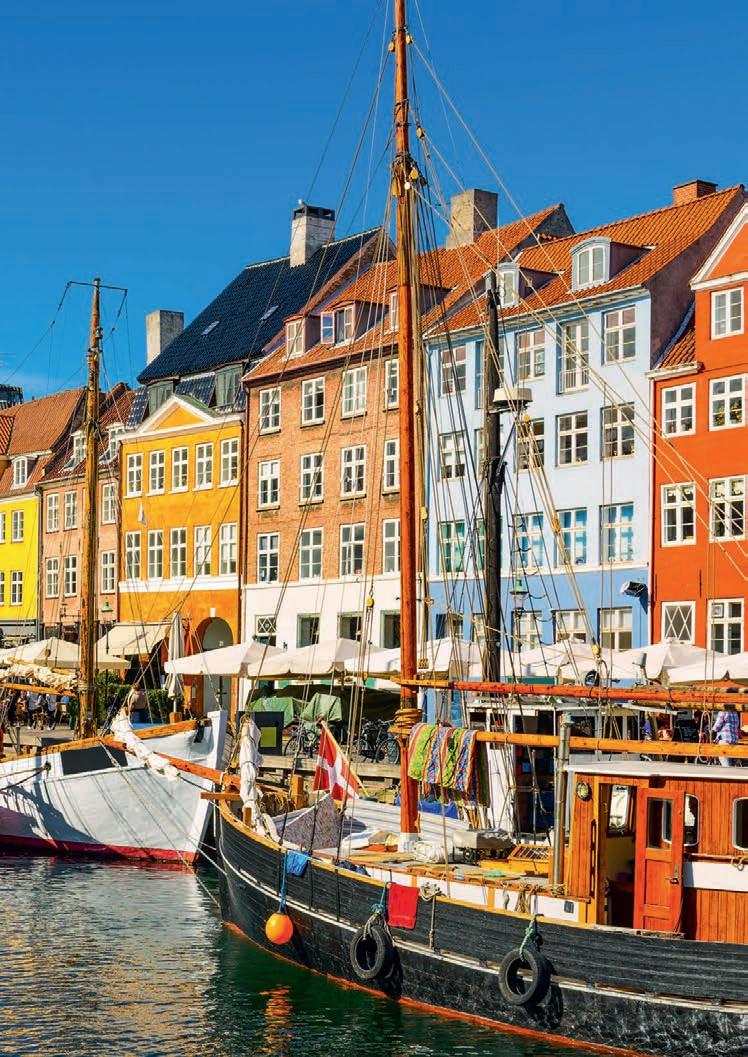























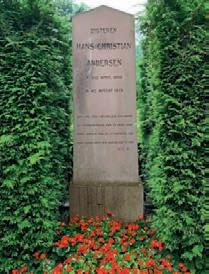







































































174 June/July 2023

USA FOOD HOTSPOTS www.wanderlustmagazine.com 175



















































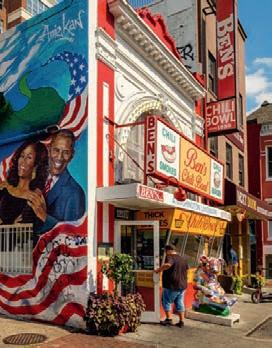


































































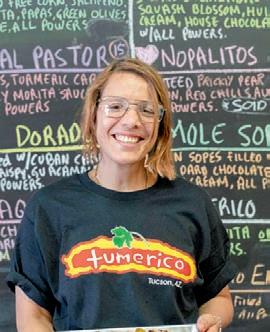














































































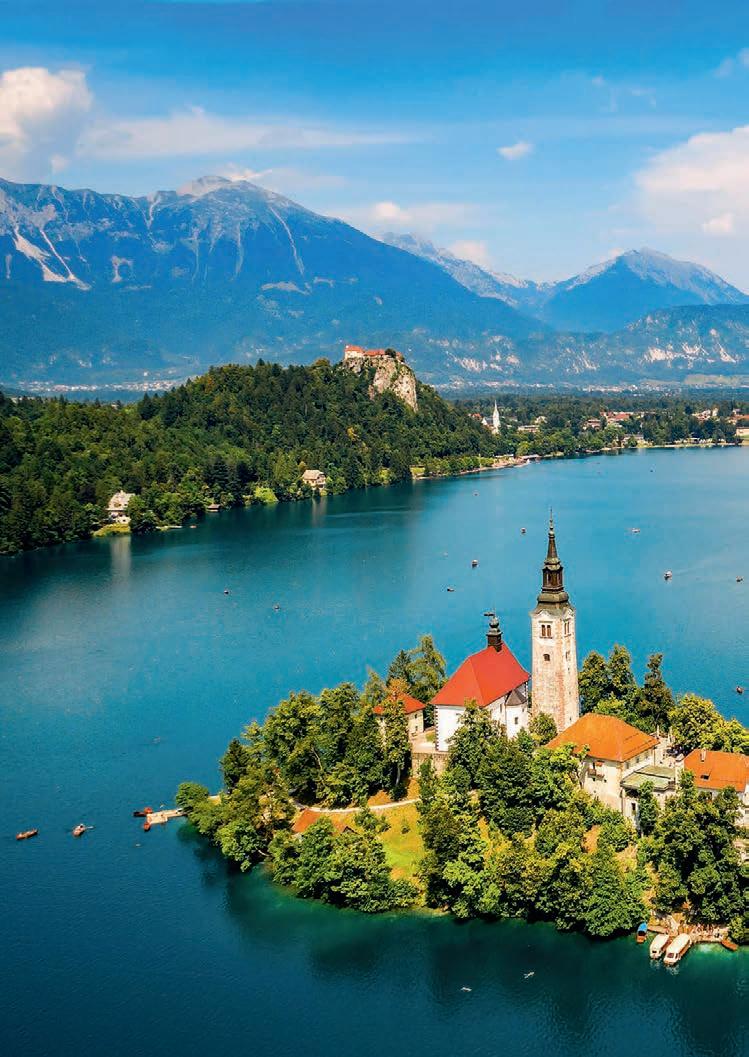
EUROPEAN BREAK MINI GUIDE
The Julian Alps, Slovenia
In a country where even locals will stop in their tracks and stare at the magnificence of their surroundings, the Julian Alps are on a level of beauty all their own, writes Steve
 Fallon
Fallon
DISCOVER Slovenia
With its lofty peaks, Alpine meadows, picture-postcard lakes and a river the colour of a cloudless sky, the Julian Alps region is Slovenia at its most photogenic. It also has the distinction of being an Alpine escape that manages to be just as appealing, if not more so, when winter fades and the skiing and hot-chocolate crowd moves on. What emerges from beneath the thaw is a landscape of iris-blue lakes, walkable trails and easily visited towns that put the history of the region on show.
Needless to say, this outpost of the Eastern Alps is a boon for lovers of the great outdoors. Beyond the pistes, the area is home to Triglav National Park, one of the largest natural reserves in Europe. Hiking, cycling and climbing are high on most visitors’ itineraries, but the real lure is the presence of a Slovenian icon: Mount Triglav (2,864m).This three-headed limestone mountain is so iconic that it appears on the national flag, and its ascent is a rite of passage among locals.
Alongside fresh air and Alpine panoramas, travellers will quickly encounter some of the bluest lakes in Europe. You certainly won’t be the first to fall head over heels in love with Bled; its glacial waters, surrounded by snow-dusted

mountains and an 11th-century clifftop castle, are home to a tiny tear-shaped island that houses an elaborate Baroque church. It’s a scene straight out of a fairy tale. Meanwhile, just a short drive to the south-west is the much larger Lake Bohinj, which is fringed by excellent cycling routes and a picturesque waterfront Gothic church.
Even getting from A to B in the Julian Alps can be an adventure. Many consider the route down into the Soča Valley from Kranjska Gora to be the highlight of any visit. On the other side of the Vršič Pass (over 1,600m high) lies the aquamarine waters of the Soča River, which gives rise to a surfeit of gorges, waterfalls and rapids before reaching the whitewater rafting capitals of Bovec and Kobarid. The latter was also the site of one of the bloodiest battles of the First World War – a history explored across museums, bunkers, hospitals and trails such as the Walk of Peace.
Indeed, while nature has been generous here, the area’s human history is every bit as compelling. Some of Slovenia’s best-preserved medieval towns scatter the countryside – bottomless treasure troves of Gothic, Renaissance and Baroque art and architecture. They also make fine bases from which to explore a region that, for all its wintry attributes, shines just as bright year round.
46.3377° N, 13.7505°
Ask a local


E
“Growing up in Bled, deep in the Julian Alps, has been a blessing for me. The area’s natural beauty and tranquillity have shaped my character and provided me with an appreciation for the environment that surrounds me. The mountains have been my playground since I was a child and I have spent countless hours hiking, mountain biking, canyoning and exploring the surrounding nature.”
Domen Kalajžič, adventurer and founder/ operator of 3glav Adventures in Bled
206 June/July 2023 EUROPEAN BREAK MINI GUIDE
The old world (this page; above) Škofja Loka has one of the best-preserved medieval centres in Slovenia, reached via a stone bridge that leads from the Capuchin monastery. If you arrive around Easter, you may catch the town’s performance of its Passion Play, which is held every six years (next one: 2026) and takes the form of a procession that involves 1,000 locals; (previous spread) the present form of Lake Bled’s church dates from the 17th century
THE JULIAN ALPS IN FOUR DAYS

Day 1: Rich medieval towns
Make a stop at Škofja Loka and its well-preserved Old Town, which is reached via a 14th-century stone bridge. Colourful medieval houses line the riverside, lying in the shadow of the town castle. Just up the road is Radovljica, where a main square opens onto a parade of 16th- and 17th-century buildings, the wonderful Beekeeping Museum and the Gostilna Avguštin, a country inn with full views of Mount Triglav.
Day 2: A bell in a church on an island in a lake
Get to know the heartthrob that is Lake Bled up close by boarding a piloted gondola that will set you
down at the island’s monumental South Staircase. Climb the 99-odd steps to the Baroque Church of the Assumption, which has a `wishing bell’ that visitors can ring if they want to ask for a special favour. Be prepared to join the queue.
Day 3: A dip and a rather cheesy detour
At the foot of the Gothic Church of St John the Baptist, take a plunge into the crystal-clear water of Lake Bohinj. Next, head north-east for a trio of idyllic villages: Stara Fužina, Studor and Srednja Vas. They are known for their Alpine dairy farming (there’s even a dairy museum in Stara Fužina), smelly mohant cheese and
wooden hayracks – used to dry grass – which scatter the countryside.
Day 4: Full tilt to a pass
Kranjska Gora is at its most elegant under a blanket of snow, but it is a spot for all seasons. With Triglav NP on its doorstep, the possibilities for hiking, cycling and mountaineering are endless, and it’s worth making the hair-raising (and spine-tingling) ascent up to Vršič Pass, which counts some 50 hairpin twists and turns. Along the way you’ll pass another iris-blue glacial lake and a chapel built by Russian POWs during the Second World War, before eventually reaching the pass at 1,611m and heading down into the Soča Valley. ⊲
Mountain highs, river thrills (this page; left–right) Triglav National Park is not only Slovenia’s largest protected area but also its sole national park, spreading across a large portion of the eastern Julian Alps – a range that the country shares with Italy; the 137km-long Soča River has become popular with kayakers of all skill levels, for whom its rapids (of varying intensity) provide plenty of action

Previous spread: Alamy; this page: 3glav Adventures; Alamy; Dreamstime DISCOVER Slovenia www.wanderlustmagazine.com 207












































































































































































































































































































































































































































































































































































































































































































































































































































































































































 Fallon
Fallon
































































































